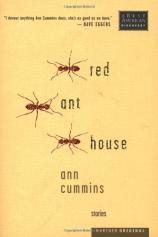Red Ant House
Review
Red Ant House
Ann Cummins sets most of the twelve stories in her debut
collection, RED ANT HOUSE, in small desert towns and reservation
communities that dot the American Southwest --- locales surrounded
by "miles and miles of sand" and not much else. This extreme
setting, which she evokes through tactile details, informs almost
every aspect of the book, creating an atmosphere of hostile
uncertainty, determining the course of characters' actions,
affecting and even invading them: "The inside of the cab felt like
sand, and so did the inside of her mouth," Cummins writes in
"Headhunter." "The tops of her arms had separated into hundreds of
little lines, and her hand, when she touched it to her tongue,
tasted like salt . . . The absence of moisture gave the landscape
an edge, like glass."
Cummins, who studied and now teaches creative writing at Northern
Arizona University, uses this jagged terrain to create tension in
her stories and evoke the desolation of its inhabitants. She
renders this landscape in rough-hewn prose that bursts with short,
targeted sentences and blunt declarations of brutal insights. The
result is a collection of textured stories that are shorn of all
unnecessary words and details: they are rangy but precise,
unpredictable but seemingly ineluctable.
Several of the stories here, including "Bitterwater" and the
standout "Trapeze," are about whites living on reservations,
"company people" who feel like outsiders and who chafe at the
wide-open boredom of the desert. They feel constantly on their
guard, never at home in their own homes, and always looking beyond
the horizon for a means of escape.
Theirs is an anywhere-but-here mentality. In the short "Dr. War Is
a Voice on the Phone," Dina abandons her sick aunt and her uncle
snoring in his chair to join a man who called her out of the blue.
For her, strangers like Dr. War are preferable to family, and the
unknown --- despite its threats and dangers --- is more attractive
than the known.
Cummins writes persuasively about this need for escape, which is
strongest and most artfully pronounced in the stories narrated by
young girls just reaching or still suffering through adolescence,
frightened by the demands of adulthood and the larger world. In
"Where I Work," a young woman cherishes her new apartment and
dreams about how she will furnish it, yet she cannot hold down a
job to pay for it. In "Bitterwater," Brenda rushes into a teenage
marriage to a Todacheene Indian named Manny, only to watch him grow
from an idealistic young man into a jaded drunk.
"Whatever's happening inside you," a cancer-ridden mother tells her
son, Peter, in "Crazy Yellow," "remember that you are about to
change. If you feel like you're in a well, you're about to climb
out of it. That's the nature of life." She doesn't warn him,
however, about the terrors that await him on the surface. Left
alone while his mother undergoes more tests, Peter stirs up more
trouble for himself than he could imagine. The tragic inevitability
of climbing out of that well makes this and the other stories in
RED ANT HOUSE so devastating.
Ultimately, these characters long for "one sweet moment" away from
the world and all its troubles. Few of them get to enjoy it, but
their dreams of something more than the wasteland around them
enliven these solid, sturdy stories and reveal Cummins as a
genuinely talented and immensely sensitive writer.
Reviewed by Stephen M. Deusner on January 23, 2011
Red Ant House
- Publication Date: April 7, 2003
- Genres: Fiction
- Paperback: 179 pages
- Publisher: Mariner Books
- ISBN-10: 0618269258
- ISBN-13: 9780618269259




